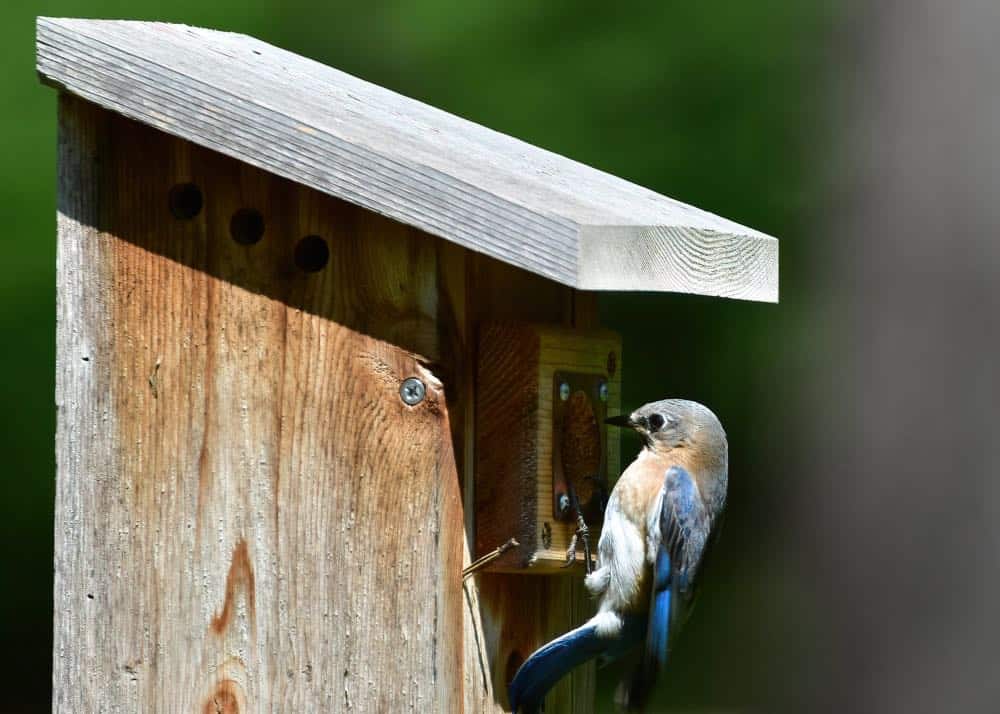Inside: Learn the secrets to placing and mounting a bluebird house so nesting bluebirds find it irresistible for moving in and raising their family.
Bluebirds are beautiful birds that symbolize happiness and are admired by almost everyone. Most people associate them with springtime in addition to joy.
These birds have gone through their fair share of setbacks, like habitat encroachment and invasive species reducing their population, but they continue to bounce back. Bluebirds are still considered protected like other native bird species in the United States.
Seeing bluebirds can put a smile on anyone’s face, but if you want to lure bluebirds to your yard, you need to be careful.
Just try not to smile after viewing this short clip:
Giving them the proper house that protects them from predators is key to attracting them and keeping them coming back to your yard.
This hobby isn’t for the faint of heart, as it takes a lot of dedication and spirit to host bluebirds successfully. You can have beautiful bluebirds in your yard with some research and commitment.
Elements of a Good Bluebird House
When designing your bluebird house, you’ll want to consider that these birds are cavity birds. They prefer to nest in small holes they find in trees, but this can be an issue since house sparrows will take the holes away from the bluebirds, kill the adults and break their eggs.
So, being careful about how you design and where you place your bluebird house will ensure you’re only attracting bluebirds and other native species.
Remember that it’s illegal to remove the nests of native bird species, so if you attract different birds than bluebirds, you can’t simply remove the nest.
Material
Wood is the most common material people use to make birdhouses. The wood is thick, sturdy, untreated, and uncured. Using rough wood gives footholds to fledglings ready to leave the nest and leaves plenty of footholds for adult bluebirds.
Recycled plastic birdhouses are also suitable. I love the easy cleaning they offer. Just make sure there are footholds available for the babies to climb out when it’s time to fledge.
Dimensions
Next, you’ll need to consider the dimensions of the birdhouse you’re adding to your backyard. The measurements will vary depending on which type of bluebird you want to attract.
Below you’ll find the floor dimensions for each type of bluebird. While the floor dimensions will change, a good rule of thumb is to make each house 9″ deep to help prevent predators. Don’t forget to include the thickness of the wood in your dimensions!
Eastern Bluebirds
Eastern bluebird houses usually have a 5×5 floor. These dimensions give fletchings plenty of room to stretch their wings.
Western Bluebirds
Western bluebirds prefer a slightly larger floor for their houses. Their dimensions are 5.5×5.5, allowing plenty of room for their wingspans.
Mountain Bluebirds
Mountain bluebirds have the largest house among the three. They prefer larger spaces, more like 6X6 inches.
Hole Size
The hole of the birdhouse needs to suit the size of the bluebirds. Bluebirds are small cavity birds, so the hole needs to represent that. Eastern, western, and mountain bluebirds need different size holes for their houses.
Eastern bluebirds need a 1 1/2″ round hole, and western, and mountain bluebirds need a 1 9/16″ round hole. The best part about these smaller holes is that they help deter larger predatory birds since they can’t fit through the holes.
Ventilation
Just like we need proper ventilation in our homes, so do birds. Bluebird houses can get too hot, so ensuring they have good ventilation will keep the birds and eggs safe. When a birdhouse gets too hot, it can cook the eggs inside, which will cause the adult birds to leave and find a better nesting location.
You should never paint a bluebird house with dark colors or use glass for the roof as that will elevate the interior temperature. As for ventilation, the top edge and small holes on the side are great ways to do this.
However, the ventilation should not let water into the house or make it too cold. Otherwise, you risk the hatchlings dying of hypothermia. It can be hard to strike a balance, but following a birdhouse designed for bluebirds or purchasing one is the best way to get a birdhouse that perfectly suits their needs.
Perches
It might be tempting to add a perch to your birdhouse, but adding one can attract predators of bluebirds. Perches are known to encourage nest destruction.
They give a foothold for territorial birds like house sparrows to corner bluebirds in their home and kill them and take the nest for themselves.
Predator Guards
We’ve mentioned it briefly before, but making your birdhouse predator-proof is important since bluebirds are smaller creatures. A predator guard will help protect adults as well as bluebird babies, and eggs.
If you want to protect your birds from predators, predator guards are necessary. There’s nothing as disappointing as opening a birdhouse that just hatched eggs, only to find them dead from a snake or predatory bird.
The video below provides instructions for a DIY predator guard.
Enough Room
You need to make sure there’s enough room in the birdhouse. It will vary from bird to bird depending on how many eggs they lay at a time and how many broods they have.
Each brood can have up to seven eggs, however, the average is four to five eggs which means your need to account for around six to seven bluebirds per birdhouse.
Slot Openings
One of the best parts about having a birdhouse is seeing the bluebirds that live in your yard. Having an entryway large enough for you to see inside while keeping them safe from predators is perfect.
The most commonly used type of birdhouse has a slot opening in the front, where you can remove the wood to look inside. You can also put openings on the side or onto the top.
Roof Type
Bluebird house roofs should be slanted to allow run-off, with a groove that prevents the water and wind from getting inside the birdhouse.
The roof should slip over the hole over the birdhouse, two to five inches, preferably five, as it deters other species of cavity birds from using the birdhouse for themselves.
If you’re using the birdhouse during the winter, the roof should keep all water away from the bird hole, as the bird hole could ice over and trap the bird inside if water drips onto it.
Painting and Staining a Bluebird House
Many people think painting or wood staining their bluebird house will make it look prettier in their yard. While that might be true, it’s not the best idea. If you want to paint or stain the birdhouse, you’ll need to use nontoxic, durable outdoor paint in a light color so the birds identify it.
If you want a birdhouse for decoration and want to stain or paint it a dark color, plug up the hole so no unsuspecting birds bed down in it.
Bluebird House Placement
What a bluebird house is made of and how it’s constructed in only half the battle. When it comes to attracting bluebirds, location is critical.
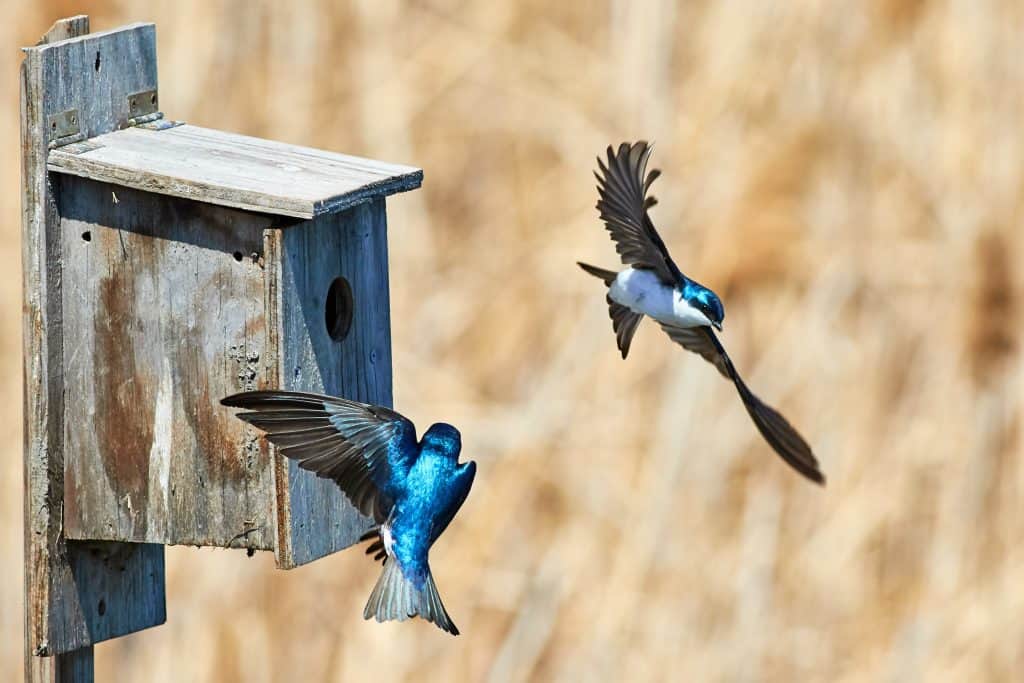
To prevent house wren and tree swallow invasions, you should avoid placing the bluebird houses in bushy areas. You should also keep them away from trees. Roadsides, fields, large yards, cemeteries, and parks fit these criteria well.
No matter how well you place your birdhouses, you’re bound to attract some non-bluebird species. If they’re an invasive species, like a house sparrow, you can destroy the nest without consequence.
Bluebirds: Three Different Species and Their Different Needs
Each bluebird species in North America (eastern bluebird, mountain bluebird, and western bluebirds) has its preferences and needs.
Eastern Bluebird
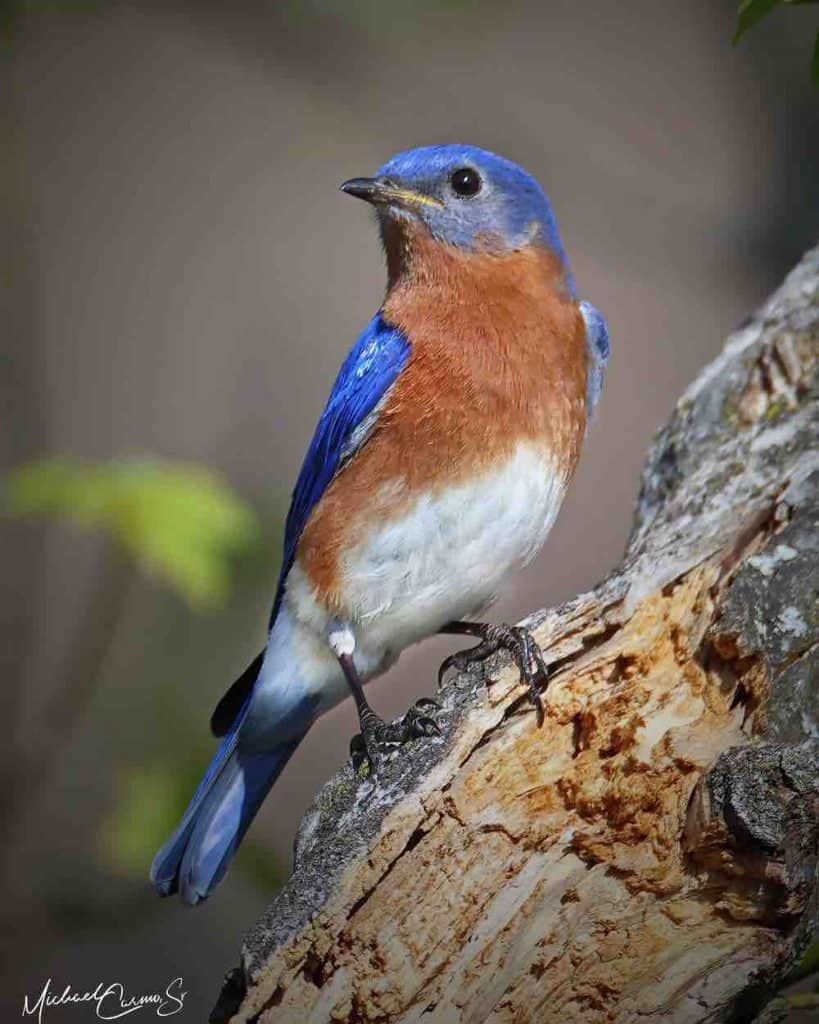
Eastern bluebird habitat consists of open meadows and fields with no ground cover, with nearby perches like telephone wires or medium trees.
Mountain Bluebird
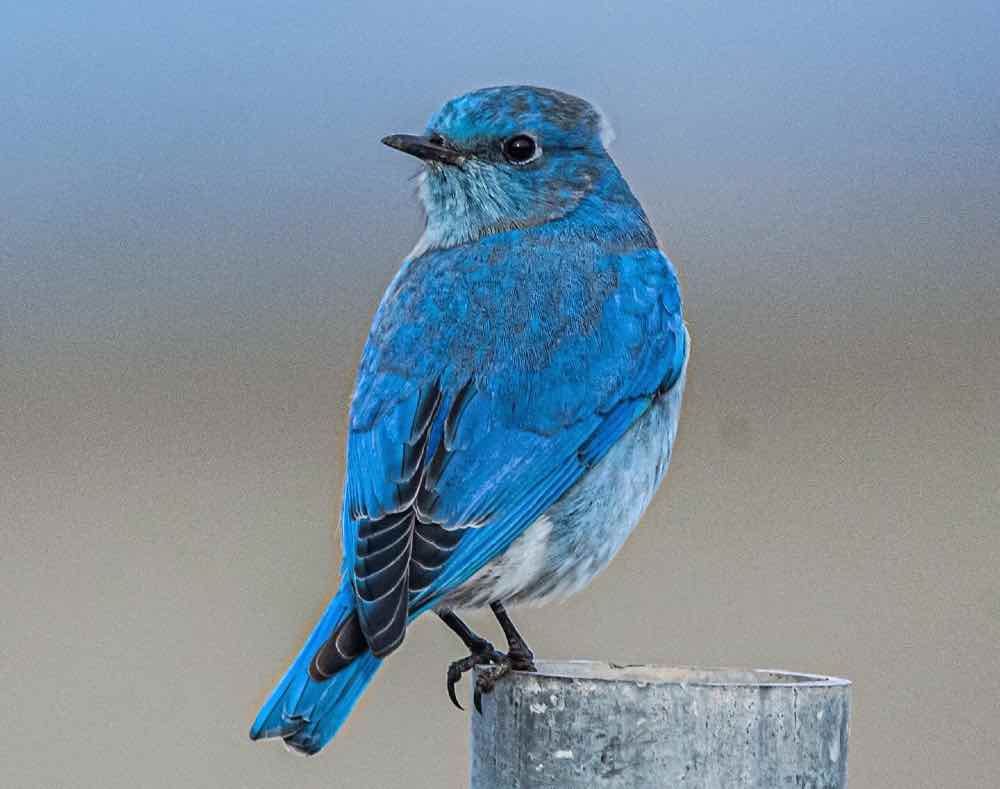
Mountain bluebirds enjoy alpine tundras and sagebrush flats in addition to the Eastern bluebird’s favorites.
Western Bluebird
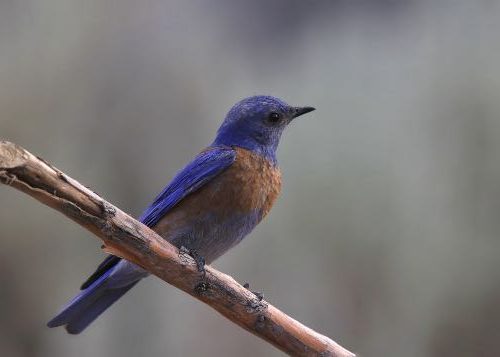
Western bluebirds prefer forests and mountains over fields and meadows, changing the habitat where you’ll place the birdhouses.
Where to Place Your Bluebird House
The best place for a bluebird house is along an empty tract of land, like a park, cemetery, or roadside. Keeping the homes away from bushy areas and forests, ensuring there are still nearby perches for the bluebirds to hunt from.
Remember, you need to monitor the bluebirds, so choose a place you can easily reach, with plenty of space for the bluebirds to find food. Most yards are suitable for one bluebird house, but ensure it fits the criteria above.
How High to Place the Birdhouse
The minimum height to install the bluebird house is at least 5′ from the ground. More specifically, 5′ from the ground to the bottom of the birdhouse.
A minimum of 5′ enables most people to easily monitor and maintain the house. It also deters predators from reaching in and attacking the nest.
Bluebird House Orientation
Bluebird houses should face the east or south, away from the prevailing winds to keep precipitation out. Some studies indicate bluebirds prefer eastern-facing birdhouses as they face the morning sun as well as away from the wind.
Place Birdhouses Away From One Another
If you’re planning to have more than one birdhouse in your yard, you need to make sure they’re not next to each other. For eastern bluebirds, place each birdhouse at least 100 yards away from each other. Mountain and western bluebirds should be 200–300 yards apart.
When they’re too close to each other, they can encroach on each other’s territory, which can cause fights and stress.
Unique Placement Considerations for Florida and Texas
The warmer the climate, the more you should consider the placement of your bluebird house.
In warmer climates, the birdhouse needs lower temperatures. Ensuring you use heat shields or screens if the temperature regularly exceeds ninety degrees during the breeding season.
Placement in Florida
It would be best to be especially cautious of snakes preying on bird eggs in Florida. Scares and baffles are great options for keeping them away, but you can prevent the problem by placing the birdhouse far from water sources and vegetation.
Placement in Texas
Ventilation is crucial in Texas, but some clever people have solved this problem by designing a bluebird house with increased ventilation for warmer climates. The Texas Bluebird Society’s plan for this house is accessible on their website for free.
Places You Shouldn’t Place a Bluebird House
There are a few places you shouldn’t place your bluebird house. Fences and trees aren’t good places because they’re easily accessible for predators to eat the birds. Anywhere that wildlife can climb isn’t a good choice.
As we’ll discuss in the next section, a pole is the best option for mounting your birdhouse because you can set the proper height in a protected location with open flight paths.
Mounting a Bluebird House
Finding the perfect spot in your yard for your new bluebird house is only half the battle. You also need to know how a bluebird house should be mounted.
Installing a Bluebird House
The easiest, and most popular method for mounting a bluebird house, is to follow The Audubon Society’s approach which uses a steel rebar pole with a steel or PVC pipe over it. The video below shows this approach.
A 4X4 post is another viable option for mounting the bluebird box.
The pole or post needs to be tall enough for the birdhouse to be a minimum of 5′ from the ground when installation is complete. So, take into account how deep you will be burying it (for stability) and where the house is mounted at the top.
For example. A 12″ long bluebird house that is buried 2′ into the ground needs an 8′ long pole for a completed height of 5′ from the ground.
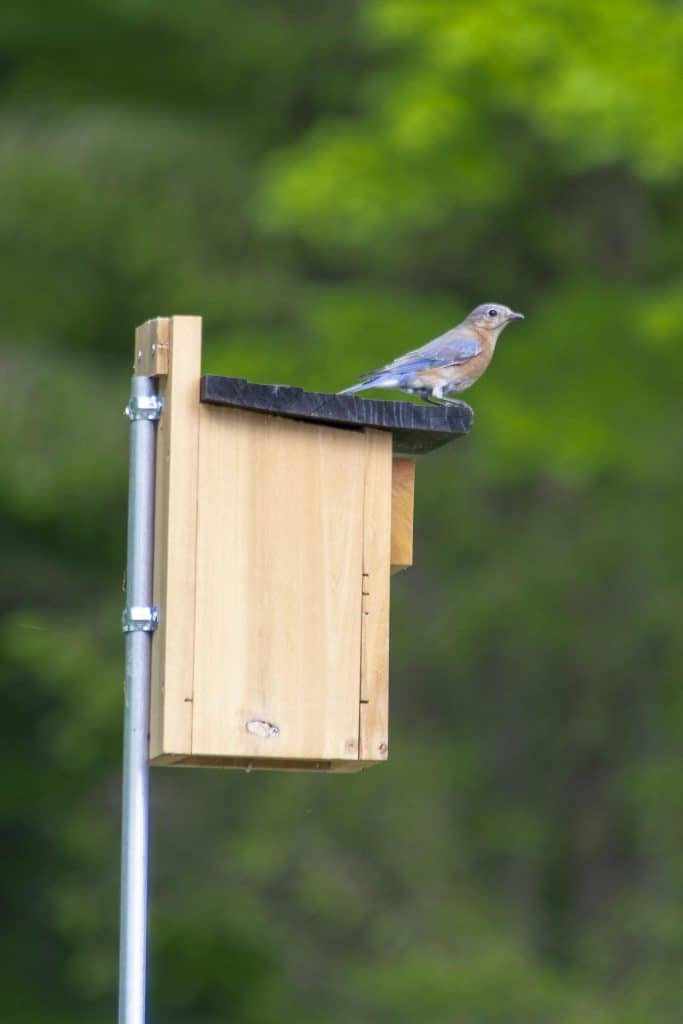
The Audubon Society’s method differs based on the birdhouse style, but it generally involves bolting the birdhouse to the pole or using brackets to attach it to a stand as depicted in the photo above.
Bluebird House Maintenance and Monitoring
You should monitor birdhouses at least once a week and clean them out after the fledglings leave the nest. However, please don’t open the box after the hatchlings begin growing their primary feathers, as it could lead to premature bluebird fledglings that leave the nest before they are ready.
To clean the house simply scrape off the debris (e.g. poop) using a stiff brush or scraper tool and brush it out of the house. If it’s really filthy or mites are a concern, you can further clean the box with a diluted bleach solution (10% bleach to 90% water). Pour the solution into a spray bottle, give it a few sprays inside the box and allow it to dry completely by keeping the door open for at least 24 hours.
After the nesting season, take the birdhouses down and clean them in the fall. Make sure you put the bluebird birdhouse back up for the winter because overwintering bluebirds use them for roosting in parts of the United States and Canada.
Preventing house sparrows from breeding in your box is an essential responsibility of owning a birdhouse, and it’s better not to provide a nesting place for them if you don’t plan on checking it regularly.
Final Thoughts
There’s nothing like having bluebirds in your yard. These beautiful creatures symbolize happiness and are sure to add a little bit to your life when they make your yard their home.
Providing these birds with a good house will ensure that they’re protected and live a long life in their new home.

